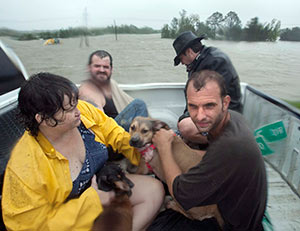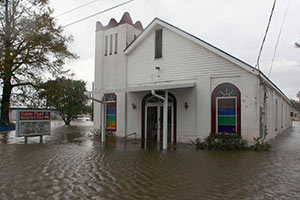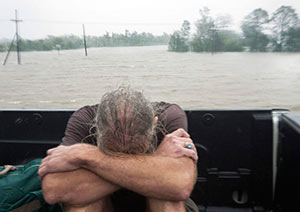NEW ORLEANS — On the seventh anniversary of Hurricane Katrina Aug. 29, Archbishop Gregory M. Aymond offered prayers for people in the Archdiocese of New Orleans impacted by slow-moving Hurricane Isaac. Rescued residents from Plaquemines Parish sit in the back of a pickup truck as rains from Hurricane Isaac flood the area Aug. 29 in Braithwaite, La. (CNS photo/Lee Celano, Reuters)
Rescued residents from Plaquemines Parish sit in the back of a pickup truck as rains from Hurricane Isaac flood the area Aug. 29 in Braithwaite, La. (CNS photo/Lee Celano, Reuters)
The storm dumped more than 15 inches of rain on southeast Louisiana and caused widespread flooding but spared New Orleans from major damage.
In a conference call with the leadership team of Catholic Charities Archdiocese of New Orleans the archbishop acknowledged the suffering of thousands of people in south Louisiana from flooding.
“We consciously place ourselves in God’s presence and ask him to give us his protection,” he said in an opening prayer. “God has always promised to protect us in challenging times, and we ask that God does that now, especially with those who are struggling.”
Retired New Orleans Archbishop Alfred C. Hughes, who was archbishop of New Orleans during Hurricane Katrina in 2005, rode out Isaac at Notre Dame Seminary in New Orleans. He called the timing of Isaac, on the same day, seven years later, from Hurricane Katrina, “rather eerie.”
“We have to be grateful that it was only a Category 1,” Archbishop Hughes told The Clarion Herald, archdiocesan newspaper of New Orleans. “The pumps seem to be working, although we’ve had some flash flooding. But there’s no serious flooding (in the city) that I’m aware of.”
Seven years ago on Aug. 29, Hurricane Katrina devastated New Orleans by blowing holes in the city’s levee system, filling more than 80 percent of the city with water.
This time, the more than $10 billion in high-tech hurricane defenses and massive pumps installed by the U.S. Army Corps of Engineers in the wake of Katrina kept New Orleans mostly unscathed. But surrounding areas sustained massive flooding from the creeping storm, which took 36 hours to clear. Floodwaters surround St. Paul Missionary Baptist Church after Tropical Storm Isaac swept through the area in Ironton, La., Aug. 30. (CNS photo/Sean Gardner, Reuters) On Aug. 30, areas of St. Tammany civil parish north of New Orleans reported rising water.
Floodwaters surround St. Paul Missionary Baptist Church after Tropical Storm Isaac swept through the area in Ironton, La., Aug. 30. (CNS photo/Sean Gardner, Reuters) On Aug. 30, areas of St. Tammany civil parish north of New Orleans reported rising water.
Archbishop Aymond could not confirm immediate damages to archdiocesan property, but parishioners of Assumption of Our Lady Mission in Braithwaite, south of New Orleans, said their parish sustained heavy flooding.
Archbishop Aymond visited first responders in the affected area on the afternoon of Aug. 30.
Fr. Joseph M. Tran, pastor of St. Thomas Parish in Pointe a la Hache and Assumption Mission, said the small Braithwaite church, spiritual home to about 100 families, was on high ground and had never flooded before. He received reports of 6 to 7 feet of flooding from parishioners.
“That really surprised me,” said the priest, who was on his way back to Louisiana after having evacuated to Birmingham, Ala. “Assumption was never flooded, not for (hurricanes) Betsy, Camille or Katrina.”
Catholic Charities moved 22 family members who were residing at a homeless family shelter program to a nearby hotel after leaks to the residence made it unsafe for them to remain there, said Martin Gutierrez, vice president of Catholic Charities.
Another program, Padua Pediatrics for children and teens with severe developmental difficulties, had only emergency power, but not enough to power the air conditioning.
“We have some industrial-sized fans to circulate the air,” said Samantha Pichon, a Catholic Charities vice president.
The archdiocese also received reports of flooding at Ascension of Our Lord Church in LaPlace, St. Anthony rectory in Lafitte, St. Patrick Church and rectory in Port Sulphur, Our Lady of the Lake Church in Mandeville and St. Anselm Church in Madisonville.
 A resident of Plaquemines Parish, rescued from his flooded house, sits in the back of a pickup truck during Hurricane Isaac Aug. 29 in Braithwaite, La. (CNS photo/Lee Celano, Reuters)Schools in the archdiocese were expected to remain closed until Sept. 4.
A resident of Plaquemines Parish, rescued from his flooded house, sits in the back of a pickup truck during Hurricane Isaac Aug. 29 in Braithwaite, La. (CNS photo/Lee Celano, Reuters)Schools in the archdiocese were expected to remain closed until Sept. 4.
The archdiocese was also making plans to get direct financial assistance to those most impacted by the storm though a donation page at www.ccano.org.
Catholic Charities USA also established a Hurricane Isaac Fund Aug. 29 to help meet the immediate and long-term needs and was accepting donations at https://www.catholiccharitiesusa.org/sslpage.aspx?pid=2357.
Fr. Larry Snyder, president of Catholic Charities USA, said the agency’s “experience with Katrina puts us in a strong position to know what needs to be done and to deliver our disaster case management services over an extended period of time.”
Catholic Charities USA has been receiving regular reports and updates from its agencies in Florida, Alabama, Mississippi, Louisiana, and Texas – all of whom have been prepared for Isaac and were ready to partner with other responding agencies and local authorities to provide immediate relief and shelter.
Currently, the agencies are relying on monetary donations to help those impacted by the storm.
“Financial donations are always our first preference if people far away want to help,” said David Aguillard, executive director of Catholic Charities of the Diocese of Baton Rouge, La. “In the first few weeks, we rely 100 percent on donations and grants to purchase relief supplies, buy gas cards and fill the gaps in services.”
Carol Spruell, communications coordinator for the agency, said often after a disaster, people’s first instinct is to “clean out their closets and send us their used clothing.”
“Those donations consume volunteer time and precious warehouse space,” she said.
During the immediate aftermath, Catholic Charities accepts some donations for specific items such as toiletries and new clothing, particularly socks and underwear.
“For a man who has lost everything,” said Spruell, “an unopened package of new socks could be treasured.”
When a disaster leaves the front-page news, offers to help subside and donations slow to a trickle.
“When the national news crews leave, that’s really when the hard work begins,” said Aguillard. “The needs are often greater months after a disaster. FEMA and insurance settlements can only go so far for people who have lost everything.”
Catholic Charities of the Diocese of Baton Rouge offers specific tips for best ways to donate for disaster relief. It suggests checking first with local agencies to find out the needs and donating new clothes, household goods or gift cards.
